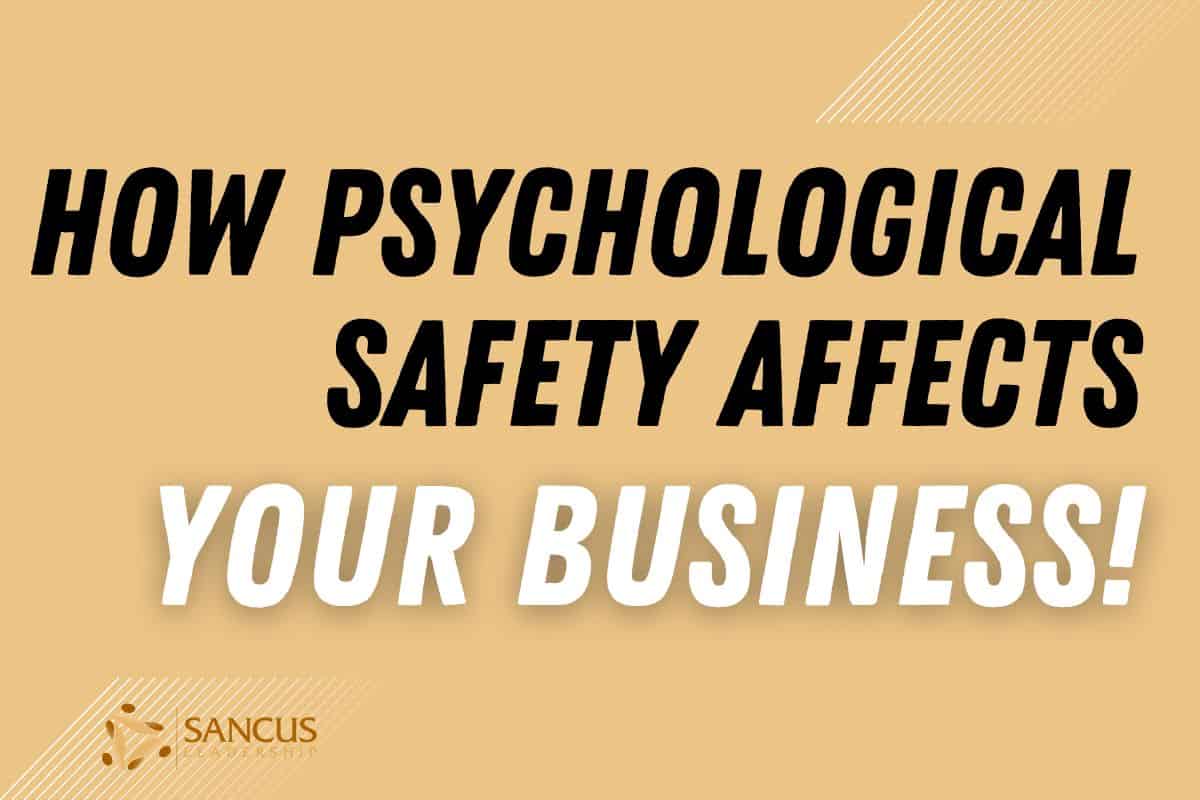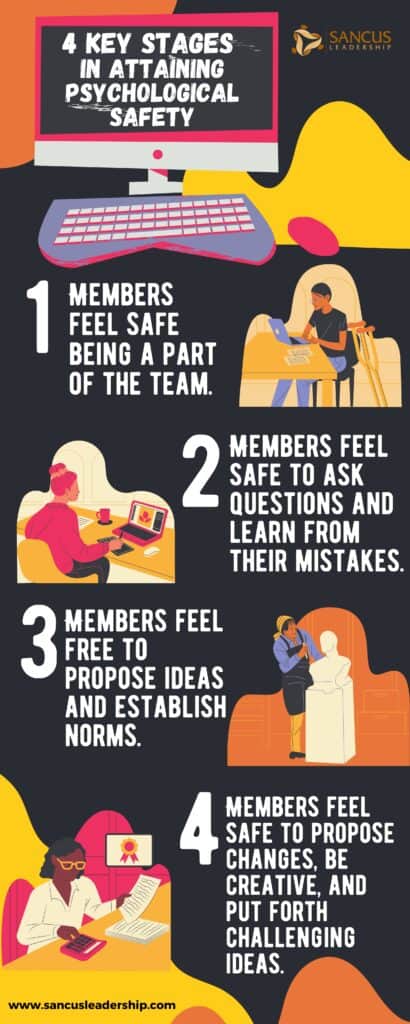Your cart is currently empty!

19(+1) Ways Psychological Safety Impacts Your Business!
A safe working environment is a fundamental right formally recognized by the International Labour Organization during its 2022 Conference. In the words of ILO, a safe working environment is a precondition for decent work. This declaration has come to support years of research around workplace safety in its diverse facets, and one of them is psychological safety.
Psychological safety refers to a workplace culture that fosters security, freedom, and confidence among employees. It grows from the certainty that members of a working team will not humiliate, judge, or penalize you when you speak your mind, make mistakes, or share and question ideas.
In this post, I’ll explore the development of the concept of psychological safety and its benefits for the workplace. I’ll also discuss the factors that make the workplace psychologically safe, compare psychological and emotional safety, and explain why psychological safety is an essential aspect of organizational culture. Let’s get to it!
What Are the Three Benefits of Psychological Safety?

The positive work environment created when people feel psychologically safe at the workplace comes with innumerable benefits. These three benefits are recorded at the individual, group, and organizational levels.
| Individual Level | Group Level | Organizational Level |
| Improved employee physical, emotional, and psychological well-being | Improved team performance | Reduced employee turnover and absenteeism rates |
| Happier and less stressed employees who are more confident in their abilities and contribution to the organization | Better collaboration toward the company or organizational goals | Higher employee motivation and engagement |
| A positive attitude towards work and a greater tendency towards knowledge sharing | Boosted ability to learn from mistakes | Reduced need to supervise working teams |
| Freedom to voice one’s ideas and critiques to colleagues and the managing team | Healthy group dynamics and improved conflict resolution | Employees that function as brand ambassadors |
| Greater skill preparedness and willingness to learn | Greater respect and trust between managers and employees and among employees | |
| Spontaneous knowledge and information sharing | ||
| The creation of inclusive teams | ||
| Increased readiness to raise safety and security concerns |
Benefits of Psychological Safety at the Individual Level
- Improved employee physical, emotional, and psychological well-being. All three aspects promote higher performance.
- Happier and less stressed employees who are more confident in their abilities and contribution to the organization. Happy employees show greater engagement.
- A positive attitude towards work and a greater tendency towards knowledge sharing. As a result, creativity and collaboration are enhanced.
- Freedom to voice one’s ideas and critiques to colleagues and the managing team. This helps improve decision-making processes, working strategies, and goal realization.
- Greater skill preparedness and willingness to learn. Employees readily apply the learned skills to their roles.
Benefits of Psychological Safety at the Group Level
- Improved team performance. This happens because members inspire each other with new ideas and challenge the improvement of existing ones.
- Better collaboration toward the company or organizational goals. The sense of belonging in the team is extended to the entire company, creating a sense of “our company.”
- Boosted ability to learn from mistakes. Mistakes compel members to rethink their ideas, leading to more polished outcomes.
- Healthy group dynamics and improved conflict resolution. Both are key to greater productivity.
- Greater respect and trust between managers and employees and among employees. Because both employees and the management are part of the team, that builds the security and freedom characteristic of psychological safety.
- Spontaneous knowledge and information sharing. This leads to improved performance, decision-making, innovation, and shorter product time to market.
- The creation of inclusive teams. Here, members feel part of the group irrespective of gender, race, color, or social and political background.
- Increased readiness to raise safety and security concerns. This helps reduce incidences of insecurity and safety risks.
Benefits of Psychological Safety at the Organizational Level
- Reduced employee turnover and absenteeism rates. Psychological safety encourages employees to identify with the company. As a result, the company is saved from consistent recruitment costs.
- Higher employee motivation and engagement. Both lead to increased productivity and profitability for the company.
- Reduced need to supervise working teams. As such, managers and leaders can focus on core management roles rather than petty supervisory roles.
- Employees that function as brand ambassadors. Employees sell the company name and product/credibility wherever they go, leading to greater credibility in the company, increased sales, and interest in working for the company among top-notch job seekers.
Ready to start Building Psychological Safety That Actually Matters?
What Is an Example of Psychological Safety?
There are many companies and organizations that have embraced psychological safety as a core driver of employee engagement and company success.
An example of psychological safety can be drawn from Google’s Project Aristotle. The project helped the multi-service technology company discover that “a bunch of smart team members” does not make a team effective. Instead, psychological safety has the most significant impact on team effectiveness.
The project helped the multi-service technology company discover that “a bunch of smart team members” does not make a team effective. Instead, psychological safety has the most significant impact on team effectiveness.
Here’s a quick video of Charles Duhigg, the journalist and author of “Smarter Faster Better,” sharing the findings he acquired from his time spent with Google’s Project Aristotle, a research team formed to examine the dynamics of team performance.
The project was guided by a famous maxim of the Greek philosopher Aristotle: “the whole is greater than the sum of its parts.” But researchers in the project also made other key discoveries about team effectiveness and psychological safety:
- Team effectiveness is largely dependent on conversational turn-taking, a core indicator of psychological safety. In Project Aristotle, the effective teams had different numbers of smart people and diverse leadership qualities. However, the single characteristic that defined team effectiveness was that members got equal chances to speak.
- Psychological safety is not an “on/off” team experience. Instead, it consistently characterizes the team once it is established. In Project Aristotle, teams that did well in one assignment did well in all the others. Those that failed in one assignment failed in all the rest.
- Effective teams have high social sensitivity. In project Aristotle, members of the team were attentive to the feeling and viewpoints of others and made an effort to understand and respect them. This was shown by the team members’ ability to read facial expressions, notice voice tones, and decipher nonverbal cues from other team members.
These core aspects of psychological safety will be lacking in situations where managers and team members do not give employees/colleagues a chance to air or explain their views.
What Is the Goal of Psychological Safety?

The goal of psychological safety is to create an organizational culture where employees feel comfortable sharing ideas, questioning, and challenging the status quo without the fear of being penalized. As a result, employees perceive working teams as a safe haven for interpersonal risk-taking.
Team members in organizations where the goal of psychological safety is achieved are happier, more engaged, and consistently keen to raise pertinent issues that are core to the organization’s mission. As such, realizing the goal of psychological safety leads to the achievement of organizational goals.
Team members in organizations where the goal of psychological safety is achieved are happier, more engaged, and consistently keen to raise pertinent issues that are core to the organization’s mission.
In working teams, attaining the goal of psychological safety happens in 4 key stages:

- Members feel safe being a part of the team.
- Members feel safe to ask questions and learn from their mistakes.
- Members feel free to propose ideas and establish norms.
- Members feel safe to propose changes, be creative, and put forth challenging ideas.
Entire teams and individual team members may move through these stages at different rates. What matters is achieving the goal of creating a team that’s safe for risk-taking.
What Makes the Workplace Psychologically Safe?

A psychologically safe workplace is made by a cultural shift involving both managers and employees. It has to do with the gradual adoption of practices and attitudes that create a working environment characterized by growth.
Below are five fundamental practices and attitudes that persons managing or leading a team can adopt to create a psychologically safe workplace.
- Educate employees on the importance of psychological safety and their role in attaining it. You can do this as part of induction or ongoing training initiatives by introducing the organization’s psychological safety culture and communicating the expected employee behaviors that support it.
- Be the first to need a psychologically safe work environment by acknowledging your fallibility. Employees will feel psychologically safe if their leader or manager is the first to admit mistakes, seek advice, express doubt in decision-making, and apologize when in the wrong. Let employees hear you acknowledge “we all make mistakes” from time to time.
- Present work as a learning experience rather than an outcome problem. Nurture a calm and constructive reaction towards mistakes and failure. When employees make mistakes, they should be able to acknowledge them without the fear of being punished. This creates the right atmosphere for learning and improving from mistakes.
- Create a free work environment where everyone can communicate freely. This should be borne from the realization that communication is at the heart of psychological safety. When those in leading roles speak up, express curiosity, ask questions, or challenge existing ideas, employees gather that the same is also permitted of them.
- Reward team success rather than individual success. This means acknowledging the positive environment of trust and respect that’s at the core of team success. Doing so convinces team members that it’s important to work as a whole rather than as isolated parts.
What Is Emotional vs. Psychological Safety?

Emotional safety comes from couples therapy, while psychological safety comes from organizational practices. However, both concepts are related to a positive work culture and are consciously promoted to enhance employee well-being, sense of security, and confidence.
Like psychological safety, emotional safety is often defined as the feeling of security, confidence, and freedom that allows one to be themselves and express their views without apprehension.
In addition, similar strategies are proposed to establish psychological and emotional safety in the workplace. These strategies include:
- Promoting open communication and active listening.
- Encouraging risk-taking without the fear of being penalized.
- Avoiding a blame culture among team members.
- Setting an example of vulnerability when in a leading or managing position.
- Rewarding successful teamwork.
Because of these similarities, emotional and psychological safety are often used as synonyms.
However, emotional safety and psychological safety developed in different contexts:
| Emotional Safety | Psychological Safety |
| Developed as a model of couple therapy, primarily focusing on how couples in an emotional relationship create a sense of safety around their partner’s ‘attachment’ and ‘esteem.’ Individuals feel emotionally safe when they perceive that their partner is securely attached and holds the other in high esteem. | Developed in the context of organizational change, initially targeting an individual employee’s sense of security within a group, and later as principally a group phenomenon. Employees are psychologically safe if they perceive their team as a haven for risk-taking. |
Over the years, both concepts have been adopted in the workplace as core drivers of a culture of safety.
Why Is Psychological Safety a Crucial Component of a Culture of Safety?

‘Culture of safety’ is a concept originally used to describe organizations that pay keen attention to the safety of their workers, especially when the work involves risks. These organizations have a way of doing things that commit to safety for both managers and frontline employees.
Psychological safety is a crucial component of a culture of safety because it is a prerequisite for safety voice. Safety voice is an employee’s freedom to speak out about safety in the workplace and avoid incidences of physical harm.
Safety voice is one of the key aspects of a culture of safety. Others include:
- Acknowledging the risky nature of an organization’s work and the willingness to provide the necessary safety measures.
- An environment where employees are not afraid of blame when they exercise their right to safety voice. As such, they can report errors without the fear of being punished or reprimanded.
- A collaborative approach across organizational ranks to build employee safety solutions.
- A managerial commitment to provide the required resources for workplace safety.
The Case of the NASA Challenger Shuttle Disaster
As an example of why psychological safety is a crucial component of a culture of safety, we can refer to the historic NASA Challenger Shuttle Disaster.
Before the shuttle’s launch, program employees in the project exercised their right to safety voice. They raised concerns that the shuttle would not function as expected in the extremely cold temperatures that prevailed.
Unfortunately, the project managers approved the shuttle’s launch despite the warning from the program employees. The artifact blew up a minute and 13 seconds after takeoff, killing all seven crew members.
Evidently, no manager at NASA would have wished for the crew’s death and the project’s eventual failure. Nonetheless, a report by an investigative commission indicated that the prevailing organizational culture at NASA was to blame for the disaster.
That leads us to think that if a strong culture of psychological safety existed, the crew’s concern would have been taken seriously, and the fatal disaster could have been avoided.
NASA used this and other incidents as learning experiences to create two crucial initiatives that support psychological safety:
- The Office of Safety and Mission Assurance. Aimed at assessing risks and creating an environment where all can point to safety issues.
- The Apollo Challenger Columbia Lessons Learned Program. A platform where past lessons are shared within NASA and with external audiences towards better future decisions.
In NASA’s case, psychological safety may not have been a prerequisite for safety voice. However, it became an aftermath of a disaster that promoted its adoption as a core component of an organizational culture of safety.
Psychological Safety: Origins and Development

The growth of the global economy largely relies on the availability and sustainment of human resources. These human resources are populated by about half of all working-age people across the world.
Typically, a company’s human resources are made of people working in teams to realize organizational goals.
As humans, working with others implies interpersonal interactions. Often, however, these interactions imply risk-taking and can threaten the psychological safety of individual employees.
Scholars dedicated to organizational research have focused on what makes people feel safe in the workplace. It has been established that feeling safe in the workplace is a core prerequisite for employee engagement and, consequently, the realization of company objectives.
It has been established that feeling safe in the workplace is a core prerequisite for employee engagement and, consequently, the realization of company objectives.
People didn’t start focusing on psychological safety just recently. The concept, which is core to employee motivation, started developing in the 1960s.
Below is a summary of the key moments and ideas that have led to the development of the concept of psychological safety as we know it today:
| Contributor | Contribution/Ideas on Psychological Safety | Chronological Period |
| Edgar Schein & Warren Bennis | First to mention psychological safety in the context of organizational change. Implied that psychological safety eliminates the anxiety of being rejected or considered unworthy. Because they don’t have to be defensive, employees can focus on company goals instead of self-defense. | 1960s |
| William Kahn | Demonstrated the link between psychological safety and employee engagement. Focused more on individual psychological safety within group dynamics. Defined psychological safety as the ability to express oneself and be involved without fear of adverse consequences to one’s status, self-image, or career. A psychologically safe work environment promotes physical, emotional, and cognitive engagement in employee roles. | 1990s |
| Amy Edmondson | Considered the pioneer of team psychological safety as we know it today. Focuses on psychological safety as a group phenomenon: psychological safety is a core aspect of team performance. Psychological safety is a common belief among team members that the group is a safe interpersonal context for risk-taking. Psychologically safe teams leave room for mistakes and have better outcomes. | 1999 to date |
Today, these contributions are being used by business leaders and managers to create workplaces where people can reap the benefits of a psychologically safe environment.
Conclusion
Psychological safety describes a way of being in working teams that assures team members they are secure and free to take risks.
Team members in psychologically safe workplaces can give ideas, ask questions, and challenge organizational practice without the fear of being punished.
Efficient managers and leaders know that teams are at the core of organizational and business success. As such, they are the first to adopt the practices and attitudes that promote psychological safety.
